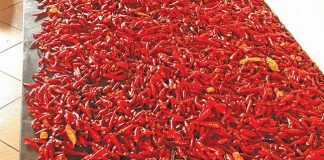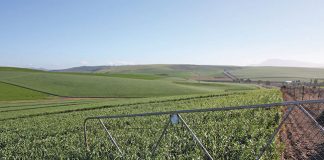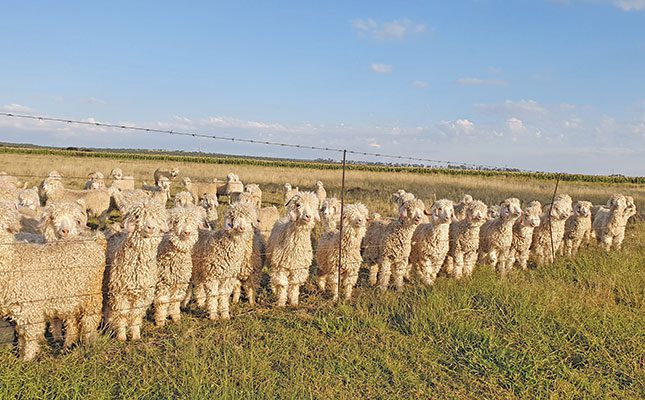
Photo: Supplied
Brothers-in-law Petrus Marx, Reco Pieterse and Stephan Erasmus farm about 20km from Wolmaransstad in the direction of Klerksdorp. Erasmus and Marx each run an Angora stud, while Pieterse runs a commercial flock. Although they run their flocks separately from each other, they work together for economic reasons and to ensure the best possible genetics and fibre yield.
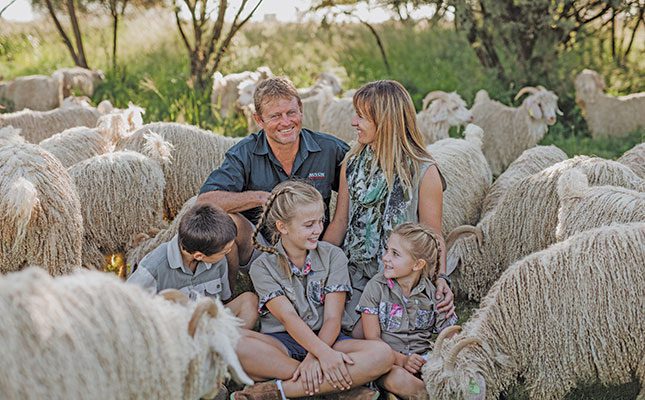
The three farmers agree that strong global demand for mohair and the high profitability of mohair production make it a good choice for extensive farming conditions. Angora are exceptionally adaptable and known for their excellent grazing utilisation.
The fact that the goats are shorn twice a year is another advantage, as it ensures a regular income.
First North West stud
Marx and his wife Angené registered the Marwyk stud in 2020, the first Angora stud to be registered in North West. Erasmus’s Erasmus Angora stud was registered a year later.
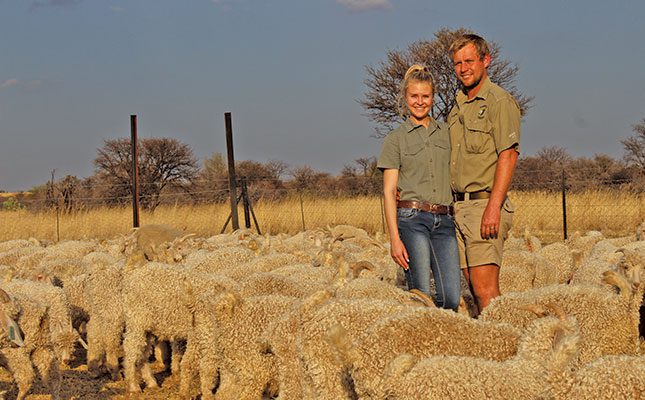
“One of the main reasons for our mutual co-operation is to buy top-quality rams together. This not only cuts costs, but allows us access to outstanding genetics that we otherwise probably wouldn’t have been able to afford. While each flock is managed independently, we share the rams for both natural pairing and artificial insemination purposes. We also work together in terms of research and development in order to breed the best possible Angoras for our farming conditions,” Marx explains.
Code of best practice
Because Angora goat production is such a new endeavour in the northern parts of the country, the trio had very little data and information to rely on. This is in contrast to producers in the Karoo, where mohair production has taken place for decades. To alleviate the problem, they keep detailed performance records of each flock to ensure well-adapted animals that deliver optimal yield.
As Erasmus puts it: “We’re in the process of compiling a code of best practice for Angora production in the northern parts of South Africa.”
Marx was the first of the three to decide on Angora goats. After he completed his BCom in 2014, he worked for one and a half years before joining his father Frans and his brother-in-law Reco on Uitval, the family’s mixed farming concern, which included game farming, cattle and grain production. After the prices of colour variants started taking a nosedive, a decision was taken to exit the game industry.
At the same time, the Wolmaransstad area was also suffering from a devastating drought, which made it necessary to look for an alternative that was adapted to extensive farming conditions and adverse climatic conditions.
“We were left with a number of game camps of between 20ha and 30ha, each with its own watering point. I had to find a farming option that could be incorporated into these camps.
After a few unsuccessful farming attempts, a friend suggested I try Angoras. I started researching these animals in earnest and came to the conclusion that the breed was a viable option for us,” he says.
The success of Angoras in the semi-arid Karoo made it an obvious choice, despite Marx’s limited knowledge about the breed. And the fact that goats, including Angoras, are browsers and grazers, coupled with their indiscriminate consumption habits, further swung his decision in favour of the breed.
The goats have in the meanwhile markedly lessened the load of invaders on Uitval such as wild asparagus (Asparagus laricinus) and bankrupt bush (Seriphium plumosum).
Fibre quality
Marx, Pieterse and Erasmus focus on issues such as the quality of the fibre, fertility, mothering abilities and conformation in their endeavour to breed Angoras specifically adapted to production conditions in the northern areas of the country.
“Our main objective is to breed well-balanced, hardy and top-performing Angoras adapted to local conditions. Petrus and I sourced our first animals from Leeu-Gamka and Murraysburg. In 2016 he brought the 157-strong Leeugamka flock to North West and after a year I decided to follow suit and acquired my first 270 animals in Murraysburg.
“During the first year after Petrus’s flock arrived, we realised the full potential of the breed as a diversification option in our area,” Erasmus explains.
Nutrition
Nutrition and proper feeding are fundamental, as they affect not only fibre quality, but also reproduction. The flocks are kept mainly on sweetveld with patches of sourveld and a strong woody component.
Kapaters (castrated goats) are kept on the veld for three months and then shifted to planted Smuts finger pastures. After shearing, the ewes are moved to natural grazing for three months before being moved to the Smuts finger pastures for lambing.
After lambing, the ewes are moved to the plains camps, which are planted to an Agricol greenfeed mixture consisting of oats, vetches, fodder radishes and stooling rye. The goats are also placed in the plains camps three months before shearing to ensure clean clips. In addition, maize stover is utilised extensively during winter.
Erasmus says it’s important to keep the mohair free from seeds and debris. Mohair is exported for upmarket clothing and upholstery fabrics, so the cleaner the fleece, the higher the prices that can be expected.
Breeding
“Only the young 18-month-old ewes are mated naturally,” says Marx. “The rams are put to the young ewes in March. For the rest of the flock, we make use of artificial insemination in order to ensure genetic diversity and integrity.
“Ram selection takes place at six months of age. The selected rams are then sent to the Karoo for an evaluation period, which means that only the best of the best rams are eventually put up for sale,” says Marx.
The rams are assessed over a six-month period by Newlands Angora in Aberdeen in the Eastern Cape, and the top performers are included in the annual Newlands Angora auction. The ram group, from different breeders, is exposed to the same regime and conditions.
The assessment procedure takes place under the auspices of The House of Fibre, an independent fibre broker. The Wolmaransstad rams are also included in evaluation trials run by the Angora Ram Breeders’ Association for inclusion in its annual sale.
Top genetics
The three associates believe in investing in genetics. To that effect, Marx acquired half a share in the ram Jan (328-170147) at the 2020 Newlands sale. Marx and Erasmus jointly bought Jan’s brother, Roelfie (339-210030), in the same year. Erasmus describes the Jan and Roelfie genetics as probably the best investments they could have made in their mohair concern.
The rams are large-framed, with strong heads and good fleece. Despite Jan’s large frame, he sired offspring with a relatively low birthweight and with exceptional growth rates. Roelfie, on the other hand, bred “the perfect ewe”, according to Marx. These two rams added markedly to mohair quality.
The trio fully support the Responsible Mohair Standards implemented a few years ago. This is a standard that supports the global mohair value chain to ensure responsible sourcing from an industry that drives sustainable and ethical production practices. According to Erasmus, it enables South African mohair producers to lead the way in the global mohair arena.
Marx, Pieterse and Erasmus give Petrie Maré, the manager responsible for market development and animal genetics at The House of Fibre, much of the credit for their success.
“Between himself and us, a whole new production area was established in North West. His advice and support have been invaluable. He visits us at least four times a year to assist with the classing of the animals, and to give genetic advice and guidance on the preparation of the clips in this area,” says Marx.
Email Petrus Marx at [email protected].









